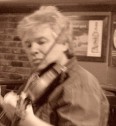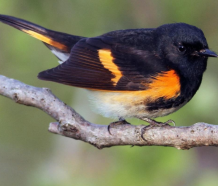The first two photos are snaps of the infrequently seen (for me) Chestnut-Sided Warbler. The image on the right is an American Redstart, somewhat more common (for me). Click to enlarge. Both are North American warblers and both paid me a visit on my morning walk today.
I’m not an obsessive birdwatcher or anything, but I have devoted some time during my life, especially in younger decades, to observing, studying, and learning about them. I’d estimate I’ve probably seen more than a third of the approximately 700 or so species normally visible within the continental United States during my lifetime. I would definitely notice it when I suddenly hear and/or see a heretofore unobserved species — thus incrementing by +1 what is typically known in birding afficinado circles as my lifelist. Once you get above forty or fifty species you’ve pretty much exhausted the province of the casual observer and are into the territory where new species sightings become accompanied by definite lasting memories as to the whys and wherefores contextualizing the new observation. That’s the territory I’ve been in for awhile now. My previous new sighting memory, if I’ve got things right, is the garrulous gannet which I encountered in droves and even colonies on a trip to Gaspé, at the mouth of the St. Lawrence, almost a decade back. It happened again this morning, through no particularly extraordinary or even ordinary effort of my own. It was just there, six feet away from me, flitting about for a nice span of 90 seconds, clear without binoculars: a chestnut-sided warbler.
First I saw the flash of color, a hint of yellow. Warblers move fast, and frequently. Also, they are small, 4-5 inches long usually — so a bit smaller than a sparrow. But I got lucky with this one. It chose to settle on a fallen tree section, still attached enough to the trunk to be leafing, directly at the side of my path. I knew straightaway it was a warbler by the melodious and high-pitched song, which also gave it away as a male interested in breeding. This in turn meant optimal plumage coloring. Though not really into ‘birding’ per-se for years, I instinctively went into my field watching routine, taking note of what would be key identifying features. Normally you have to really hurry with warbler observing, but this fellow was super cooperative and seemingly unaware of my presence. I mentally noted the helpful identifying markers: bright yellow head crown, black facial streak from beak through eye, starkly contrasting whitish cheek, patterned black, browns, and greys on back. Meanwhile I did my darndest to try and memorize it’s song. A key break came about ten seconds before the bird departed, flying over my head up into the trees on the other side of the trail. It twisted it’s body and lifted the wing a bit, revealing a distinctive bright reddish-brown streak along it’s side — what hue is usually known in birder’s parlance as chestnut. I knew I’d not previously witnessed this warbler, but I recalled enough lore from the past to know that the word ‘chestnut’ appeared within the common name of one of the N. American warblers. I stored all this info on the tip of my hat until I could get home to check matters online. Happily, as a bonus, a few yards further on I came across a redstart singing and flitting about a little higher up in the trees. Also a very nice warbler to happen across with it’s sharply contrasting black and orange coloring!
“Chestnut-sided Warbler populations declined by about 44% between 1966 and 2015, according to the North American Breeding Bird Survey. Partners in Flight estimates a global breeding population of 19 million with 30% breeding and migrating through the U.S., 70% in Canada, and 9% wintering in Mexico. It is a U.S.-Canada Stewardship species, and rates a 12 out of 20 on the Continental Concern Score. Chestnut-sided Warbler is not on the 2016 State of North America’s (endangered) Birds’ Watch List. Numbers have declined in part due to loss of habitat.” – Cornell University Ornithology Dept.
Warblers are considered by some the pinnacle of the bird watching experience (though many would place the raptors — birds of prey — in this position, and some would even select the maritime species). What enchants many about warblers is the ephemeral nature of their viewing windows. They are small and move fast, designed for efficient capture of insects on the wing, which comprise almost the entirety of their springtime diets. Most warblers — there are about 30 N.American species — develop a splash of characteristic colors, often only in the males, during breeding season. In the temperate zone they are migratory, and pass through from late April to late May. This time slot coincides with the budding and early leafing of the forests and woodlands, when there are usually billions of freshly hatched insects of all varieties. They often lurk relatively high in the trees, explaining the craning necks of binocular-toting birdwatchers in the wild places this time of year. Soon as the foliage cover fills out warblers become much more difficult to spot. By June, the singing (and mating) has reduced and the breeding plumage begins to dull. Plus, many species then move further north to feed in the tundras. In New Jersey, where I used to live, the warbler window peak was about May 5th to May 12th. But up in Canada, in the Laurentians, where I live nowadays, there is still excellent viewing opportunity now in late May. The other prized feature of warblers, of course, are their brilliant calls and songs. Among the most complex and sweet of the avian world. You can listen to ‘my’ warbler, the chestnut-sided, here.
[ Range of the Chestnut-Sided Warbler – it’s mainly an eastern bird ]
In researching the chestnut-sided warbler, I figured out it was likely eating insects or insect eggs from the undersides of leaves in the fallen tree it was perched in. I also discovered it has suffered a steep population decline since the days of my infancy. But it is not officially considered endangered at this point since most of the decline is due to habitat loss rather than less gradual or more dire factors such as invasive introduced species or pollutants. If curious, you can survey a professionally photographed gallery of the warblers, courtesy of Glenn Bartley. A few common ones, such as the ovenbird and the common yellowthroat, hang around in the temperate zone and can be spotted or heard throughout the summer, if you are patient. Most warblers winter in the far south of the U.S. or in Mexico or Central America.
Makes me wonder how many years it will be before the next new bird is added to my lifelist, and what it might be. There are a few plausible candidates now that I’m residing five degrees latitude further north. Perhaps a great grey owl will wander over from western Ontario. Almost makes me want to dust off the old guides and paraphernalia — but not quite.
_______RS
On the off chance I’ve managed to intrigue 1% of readers into looking into things more deeply, a great organization devoted to tracking, monitoring, and improving the lives and fortunes of North American birds is: Partners in Flight. There are various ways the novice can get involved.
► Handy INDEX — scan through all available ||SWR|| articles





That’s a fascinating hobby. (Sounds strange to call it that, for the birds may be choosing to reveal themselves to you.) I confess I don’t often look too closely at birds but I am surprised and intrigued when I hear a new song/voice. Every night while washing dishes I get to watch a committee of turkey vultures make their way to the silver birches outside the kitchen window. There are about 25 of them, but strangely enough, I’ve never heard a vulture sing or make any sound.
You know, I bet they are roosting there. When they congregate at dusk and go quiet, they are settling down for night. Once I disturbed a TV roost unwittingly just after dusk, off path, in a woods, and the things clamored around and crashed into each other in chaos, rushing to flee. You’re right about their calls, I think. If I recall all they really do is emit guttural squawks & you have to be close to hear them. 25 is a big group! Cool.
They have claimed these trees as their summer home for many years now. A doctor whose office was right next to those trees got fed up with all the vulture poop he had to step in and took a shotgun to them about ten years ago. (I need to ask my landlord.) But they returned with a vengeance:)
Happy Weekend 🙂
Grazie… you too. Though I guess yours has already begun 🙂
Nice aren’t they! More often heard than seen. I tried to get a decent picture of a yellow throat the other day, not a chance. You can hear them calling all summer long: “we see, we see, we see” then flitting about but even if you do the “tsit-tsit-tsit-tsit” calls with lips and tongue which often works for sparrows, towhees and chickadees, the warblers aren’t impressed at all. Nice pictures, for sure!
yeah, they’re great. Had a yellowthroat out my window in someone’s garden below once, in a condo in Newark NJ, can you believe it! always seems they find you rather than the other way around. I immediately bopped over to enature.com and played its call out the window — had fun with it for a few minutes.
What a beautiful song! I’m not an avid birdwatcher, but I camp a lot and make a point to notice the wildlife. I’m increasingly interested in learning to id the birds I already know by their calls, so I found your link out to the audio especially interesting. The warbler has a lovely voice.
It’s a neat discipline, the audio side of it. Come to learn that most bird species have 2 or 3 distinct sounds, one for announcing territory, one for warning of danger, etc. I heard one this morning high in a pine tree — no possible way to get a visual, so I have to try and sound-id it. (in my copious free time) 🙂